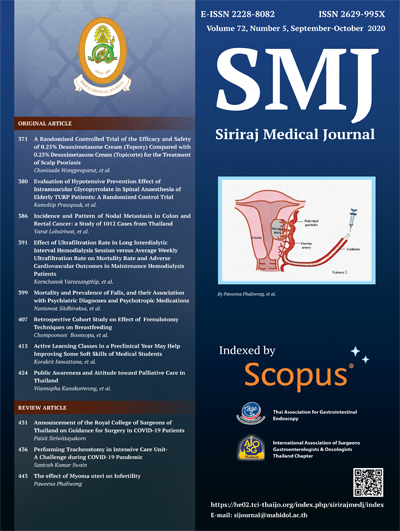Effect of Ultrafiltration Rate in Long Interdialytic Interval Hemodialysis Session versus Average Weekly Ultrafiltration Rate on Mortality Rate and Adverse Cardiovascular Outcomes in Maintenance Hemodialysis Patients
DOI:
https://doi.org/10.33192/Smj.2020.53Keywords:
ultrafiltration rate, cardiovascular outcomes, mortality, maintenance hemodialysis patients, long interdialytic interval hemodialysis, weekly hemodialysisAbstract
Objective: Cardiovascular events are more commonly observed during hemodialysis sessions after a long interdialytic interval compared to average weekly hemodialysis sessions, and ultrafiltration rate (UFR) was reported to be associated with cardiovascular outcomes. Whether the UFR during hemodialysis sessions after a long interdialytic interval is a better predictor of cardiovascular outcome than the average weekly UFR is unknown.
Methods: The charts of patients aged >18 years with end-stage renal disease that received hemodialysis treatment Siriraj Hospital during January 2008 to December 2017 were retrospectively reviewed.
Results: Two hundred and forty-one patients (52.8% females) were included. During the median time follow-up of 54 months, the rate of adverse cardiovascular outcomes was 7.26 events/100-patient-years, and the mortality rate was 8.40 deaths/100-patient-years. Mean UFR was significantly higher in the long interdialytic interval hemodialysis sessions than in the average weekly UFR sessions (14.07±5.29 vs.13.13±5.14 ml/h/kg, p<0.001). Compared with UFR of ≤10 ml/h/kg, the adjusted hazard ratio (HR) for mortality in the UFR >13 ml/hour/kg subgroup was 1.29 (95% CI: 0.65-2.56) and 1.05 (95% CI: 0.55-2.03) in the long interdialytic interval hemodialysis sessions and the average weekly UFR, respectively. The adjusted HR for adverse cardiovascular outcome in the UFR >13 ml/h/kg subgroup was 1.32 (95% CI: 0.64-2.80) and 0.72 (95% CI: 0.36-1.35) in the long interdialytic interval hemodialysis sessions and the average weekly UFR, respectively.
Conclusion: This study revealed the UFR in long interdialytic hemodialysis sessions to be more strongly associated with adverse cardiovascular outcomes and all-cause mortality than the average weekly UFR.
References
2. Lee MJ, Doh FM, Kim CH, Koo HM, Oh HJ, Park JT, et al. Interdialytic weight gain and cardiovascular outcome in incident hemodialysis patients. Am J Nephrol. 2014;39(5):427-35.
3. Cabrera C, Brunelli SM, Rosenbaum D, Anum E, Ramakrishnan K, Jensen DE, et al. A retrospective, longitudinal study estimating the association between interdialytic weight gain and cardiovascular events and death in hemodialysis patients. BMC Nephrol. 2015;16:113.
4. Weiner DE, Brunelli SM, Hunt A, Schiller B, Glassock R, Maddux FW, et al. Improving clinical outcomes among hemodialysis patients: a proposal for a "volume first" approach from the chief medical officers of US dialysis providers. Am J Kidney Dis. 2014;64(5):685-95.
5. Flythe JE, Kimmel SE, Brunelli SM. Rapid fluid removal during dialysis is associated with cardiovascular morbidity and mortality. Kidney Int. 2011;79(2):250-7.
6. Assimon MM, Flythe JE. Rapid ultrafiltration rates and outcomes among hemodialysis patients: re-examining the evidence base. Curr Opin Nephrol Hypertens. 2015;24(6):525-30.
7. Assimon MM, Wenger JB, Wang L, Flythe JE. Ultrafiltration Rate and Mortality in Maintenance Hemodialysis Patients. Am J Kidney Dis. 2016;68(6):911-22.
8. Kim TW, Chang TI, Kim TH, Chou JA, Soohoo M, Ravel VA, et al. Association of Ultrafiltration Rate with Mortality in Incident Hemodialysis Patients. Nephron. 2018;139(1):13-22.
9. Foley RN, Gilbertson DT, Murray T, Collins AJ. Long interdialytic interval and mortality among patients receiving hemodialysis. N Engl J Med. 2011;365(12):1099-107.
10. Agarwal R. Patients on three times-weekly haemodialysis have increased mortality during the long, 2-day interdialytic interval. Evid Based Med. 2012;17(5):161-2.
11. Flythe JE, Assimon MM, Overman RA. Target weight achievement and ultrafiltration rate thresholds: potential patient implications. BMC Nephrol. 2017;18(1):185.
12. Wong MM, McCullough KP, Bieber BA, Bommer J, Hecking M, Levin NW, et al. Interdialytic Weight Gain: Trends, Predictors, and Associated Outcomes in the International Dialysis Outcomes and Practice Patterns Study (DOPPS). Am J Kidney Dis. 2017;69(3):367-79.
13. Saran R, Bragg-Gresham JL, Levin NW, Twardowski ZJ, Wizemann V, Saito A, et al. Longer treatment time and slower ultrafiltration in hemodialysis: associations with reduced mortality in the DOPPS. Kidney Int. 2006;69(7):1222-8.
Downloads
Published
How to Cite
Issue
Section
License
Authors who publish with this journal agree to the following conditions:
Copyright Transfer
In submitting a manuscript, the authors acknowledge that the work will become the copyrighted property of Siriraj Medical Journal upon publication.
License
Articles are licensed under a Creative Commons Attribution-NonCommercial-NoDerivatives 4.0 International License (CC BY-NC-ND 4.0). This license allows for the sharing of the work for non-commercial purposes with proper attribution to the authors and the journal. However, it does not permit modifications or the creation of derivative works.
Sharing and Access
Authors are encouraged to share their article on their personal or institutional websites and through other non-commercial platforms. Doing so can increase readership and citations.















